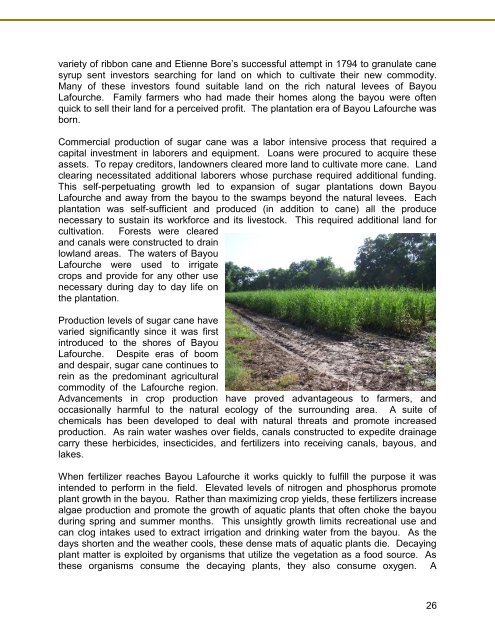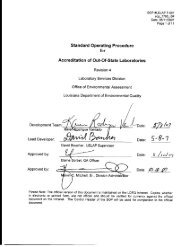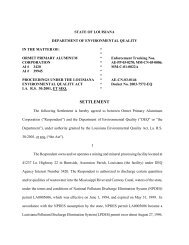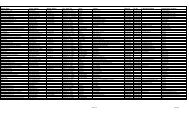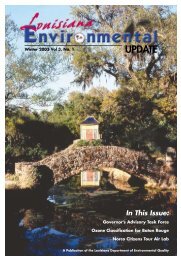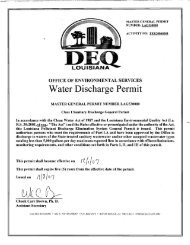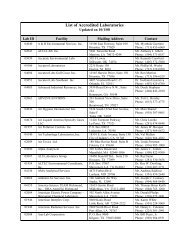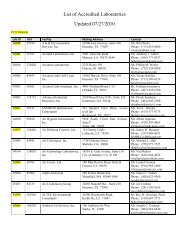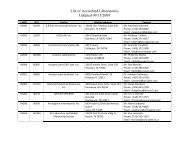Bayou Lafourche
Bayou Lafourche - LDEQ Nonpoint 319 Projects
Bayou Lafourche - LDEQ Nonpoint 319 Projects
- No tags were found...
You also want an ePaper? Increase the reach of your titles
YUMPU automatically turns print PDFs into web optimized ePapers that Google loves.
variety of ribbon cane and Etienne Bore’s successful attempt in 1794 to granulate cane<br />
syrup sent investors searching for land on which to cultivate their new commodity.<br />
Many of these investors found suitable land on the rich natural levees of <strong>Bayou</strong><br />
<strong>Lafourche</strong>. Family farmers who had made their homes along the bayou were often<br />
quick to sell their land for a perceived profit. The plantation era of <strong>Bayou</strong> <strong>Lafourche</strong> was<br />
born.<br />
Commercial production of sugar cane was a labor intensive process that required a<br />
capital investment in laborers and equipment. Loans were procured to acquire these<br />
assets. To repay creditors, landowners cleared more land to cultivate more cane. Land<br />
clearing necessitated additional laborers whose purchase required additional funding.<br />
This self-perpetuating growth led to expansion of sugar plantations down <strong>Bayou</strong><br />
<strong>Lafourche</strong> and away from the bayou to the swamps beyond the natural levees. Each<br />
plantation was self-sufficient and produced (in addition to cane) all the produce<br />
necessary to sustain its workforce and its livestock. This required additional land for<br />
cultivation. Forests were cleared<br />
and canals were constructed to drain<br />
lowland areas. The waters of <strong>Bayou</strong><br />
<strong>Lafourche</strong> were used to irrigate<br />
crops and provide for any other use<br />
necessary during day to day life on<br />
the plantation.<br />
Production levels of sugar cane have<br />
varied significantly since it was first<br />
introduced to the shores of <strong>Bayou</strong><br />
<strong>Lafourche</strong>. Despite eras of boom<br />
and despair, sugar cane continues to<br />
rein as the predominant agricultural<br />
commodity of the <strong>Lafourche</strong> region.<br />
Advancements in crop production have proved advantageous to farmers, and<br />
occasionally harmful to the natural ecology of the surrounding area. A suite of<br />
chemicals has been developed to deal with natural threats and promote increased<br />
production. As rain water washes over fields, canals constructed to expedite drainage<br />
carry these herbicides, insecticides, and fertilizers into receiving canals, bayous, and<br />
lakes.<br />
When fertilizer reaches <strong>Bayou</strong> <strong>Lafourche</strong> it works quickly to fulfill the purpose it was<br />
intended to perform in the field. Elevated levels of nitrogen and phosphorus promote<br />
plant growth in the bayou. Rather than maximizing crop yields, these fertilizers increase<br />
algae production and promote the growth of aquatic plants that often choke the bayou<br />
during spring and summer months. This unsightly growth limits recreational use and<br />
can clog intakes used to extract irrigation and drinking water from the bayou. As the<br />
days shorten and the weather cools, these dense mats of aquatic plants die. Decaying<br />
plant matter is exploited by organisms that utilize the vegetation as a food source. As<br />
these organisms consume the decaying plants, they also consume oxygen. A<br />
26


